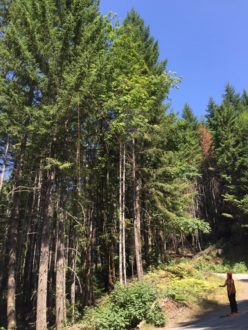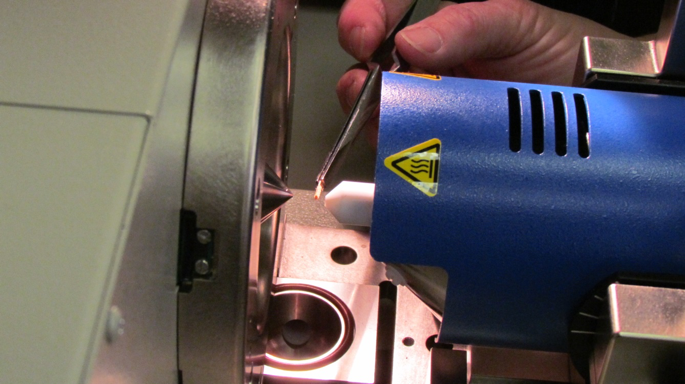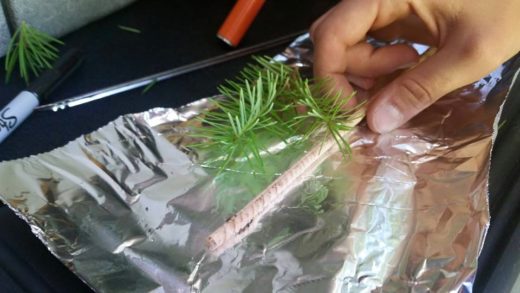- Kristen Finch, a lab technician at the US Fish and Wildlife Service Forensics Laboratory, is using the Direct Analysis in Real Time Mass Spectrometry (DART-TOFMS) machine to determine the full chemical profiles of wood samples.
- Her team has found that the chemical composition of wood core samples varied between wood collected in the Coast range of Oregon state and the Cascades range, both in the Pacific Northwest of the United States.
- If DART-TOFMS can accurately and reliably provide species and geographic source wood identification, it would be the fastest and most cost-effective tool for wood identification, a key step in reducing illegal logging.
Earlier this summer, members of the Forest Legality Alliance (FLA) gathered in Washington, DC for their Semi-Annual Membership Meeting. As a precursor to the upcoming CITES COP17 meeting in September, the FLA member meeting focused on issues pertaining to illegally traded CITES-listed timber species, proposals to add new timber species to the CITES list and wood identification technologies to aid CITES implementation.
Representing the Forensics Laboratory at the US Fish and Wildlife Service was Kristen Finch, who presented her work with the Direct Analysis in Real Time Mass Spectrometry (DART-TOFMS) machine. DART-TOFMS can determine the full chemical profile of a piece of wood, rather than identifying a timber species through the genetics or structure of a sample.
WildTech spoke to Kristen about her work and how being able to determine the full chemical profile of a piece of wood can help combat illegal logging.
WildTech: Tell us about your work.

Kristen Finch: I work at the U.S. Fish and Wildlife Service (USFWS) Forensic Lab as a volunteer and lab technician for the Direct Analysis in Real Time (Time of Flight) Mass Spectrometry (DART-TOFMS), a machine that is used to obtain a full chemical profile of a [biological] sample, which, in my case is a sample of wood.
My work at the USFWS Forensic Lab was built on previous research in wood identification conducted by Laboratory Deputy Director, Dr. Ed Espinoza, and his colleagues. Recent publications in association with the USFWS Forensic Lab suggest that DART-TOFMS is a tool that provides rapid species identification for high-risk timber species like those in the genera Dalbergia (rosewood), Sweitenia (mahogany) and Aquilaria (agarwood). Other publications suggest that DART-TOFMS may provide geographic source identification at large geographic scales, such as country and continent.
I was interested in investigating the limit to the spatial resolution of DART-TOFMS for wood identification. For example, could the DART-TOFMS distinguish wood from the same species, but from approximate but climatically distinct geographic regions? More specifically to Pseudotsuga menziesii (Douglas-fir), does the chemical variation observed among tree cores correlate with geographic and environmental differences? Do the chemical profiles from Douglas-fir tree cores originating in the Coast mountain range of western Oregon differ from those originating in the Cascades mountain range of western Oregon?
This is a collaborative project between myself, Dr. Espinoza, Dr. Rich Cronn with the U.S. Forest Service, and Dr. F. Andy Jones, my PhD advisor for Botany and Plant Pathology at Oregon State University. The analysis of these data will be included in a manuscript that is in preparation for submission to Rapid Communications in Mass Spectrometry by the end of 2016.
What is DART-TOFMS?
Direct Analysis in Real Time (Time of Flight) Mass Spectrometry (DART-TOFMS) is a method that allows for the rapid procurement of a full chemical profile for any sample with little or no sample preparation.
A researcher simply exposes the sample to a stream of helium ions heated to 450°C. The high temperature of this ion stream volatilizes chemicals on or near the surface of the sample and provides a mass spectrum (the chemical composure of the sample), which contains signals from all chemicals detected for the duration of sample exposure to the ion stream. From this mass spectrum, chemicals can be identified by estimating their mass and comparing this to a chemical database. However, it is more common that DART-TOFMS detects chemicals that have not been purified and described by past research. The power of this tool comes from its rapidity and the provision of minute chemical information.
With further testing, DART-TOFMS may prove to be a rapid and cost-effective tool for wood identification, which would be beneficial in identifying illegally logged and traded timber species.
The DART-TOFMS machine itself is available to purchase, but the USFWS Forensic Lab will host researchers who are interested in using the machine for projects that are beneficial to their understanding and use of the DART-TOFMS for endangered species identification, wood and otherwise.

How are you performing your research?
To investigate the question [of determining the geographic location of Douglas fir], 99 tree cores were collected from 23 sampling locations in the Coast range, and 89 tree cores were collected from 25 sampling locations in the Cascades range. Three annual rings from each tree core were separated and analyzed via DART-TOFMS. The mass spectra were averaged to provide a single chemical profile per individual tree. Multivariate classification models were employed to study the variation between regional classes of tree cores (Coast range vs. Cascades range).
We found that the mass spectra, or the presence and abundance of chemicals produced by a plant and stored in wood, varied between wood collected from the Coast range and the Cascades range, and could be used to correctly identify the geographic region of origin for 74.3% of tree cores.
While this accuracy percentage is promising, this research is limited by sample. More research is required to understand the capability of DART-TOFMS for geographic source identification of wood. Controlled experiments examining the contribution of genetic and environmental conditions to variation in wood chemistry will help us understand how helpful DART-TOFMS can be for wood identification.

What is different and innovative about your work and the technology you’re using?
DART-TOFMS is exciting because if it can accurately and reliably provide species and geographic source wood identification, it would be the fastest and most cost-effective tool for wood identification. The vast chemical data that is provided by DART-TOFMS could easily inspire chemistry students to purify plant natural products or community ecology students to investigate how plant chemistry affects arthropod community structure. I would love to see more students using the DART-TOFMS for projects outside of wood identification.
What technological improvements would benefit your work?
To combat illegal logging, I think that wood identification for timber screening is going to require more than one tool to incriminate an irresponsible party in the supply chain. In the future, wood identification may rely on a combination of evidence–genetic and chemical or genetic and anatomical etc.–to provide strong support for law enforcement.
Ultimately, well-equipped ports of entry supporting multiple identification tools will require a unified wood identification database containing wood chemical profiles, detailed anatomical photos and descriptions and high-resolution genetic information for all species and populations. Having a multifaceted identification database would be an ideal aid for law enforcement.
What do you think are the top five challenges to reducing illegal logging?
Where to start…
- Lack of funding for research projects incorporating controlled experiments to investigate anatomical, isotopic, chemical and genetic tools for wood identification.
- Lack of funding for demographic studies required to understand the full extent of extinction risk for high-value timber species.
- Lack of collaboration among countries on proposals for CITES listing.
- High consumer demand for high-quality timber products leading to continued harvest and trade of timber in impoverished countries.
- Ineffective law enforcement due to corruption.
